Biwako Shuko no Uta Song Monuments 琵琶湖周航の歌 歌碑
|
|
|

To mark the song's 100th anniversary, a new song monument was unveiled at Kyoto University (Yoshida-South Campus) on Nov. 25, 2017.
|
|

Front side of the monument has the Japanese lyrics and explanation of the song. Monument is made of stainless steel with a brushed-metal finish.
|
|
|
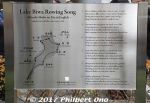
Monument's English side has a bilingual Lake Biwa map and Lake Biwa Rowing Song English lyrics.Directions: From JR Kyoto Station's Karasuma side (north side with Kyoto Tower), go to bus stop D2 and catch the No. 206 bus bound for "Gion Via Kiyomizu-dera Temple/Kitaoji Station" (三十三間堂・清水寺・祇園・百万遍). The bus leaves every 15 min. or so (bus schedule here), but it can be very crowded. The ride takes abut 30 min. Get off at "Kyodai Seimon-mae" (京大正門前). Cross the big road (Higashi-Oji-dori) and walk along Higashi-Ichijo street. The main Yoshida Campus will be on the left while the Yoshida-Minami Campus will be on the right. Enter the Yoshida-Minami Campus and walk to the central courtyard area.
(From Kyoto Station, there is also an express bus (京大快速) to Kyoto University Hospital from bus stop D3, but it runs only at certain times on weekdays, mainly in the morning and mid-afternoon (bus schedule here).
|
|

Verse 1 Song Monument, Otsu (Mihogasaki). In 1973, this was the first monument built for the song. The song's first and most famous line, "Ware wa Umi no Ko" is written. 一番の歌碑。大津市三保ケ崎。This monument is near the boat house in Mihogasaki, a stone's throw from Hama-Otsu.
われは湖の子 さすらいの
旅にしあれば しみじみと
のぼる狭霧や さざなみの
志賀の都よ いざさらば
Ware wa Umi no Ko, sasurai no
tabi ni shiareba, shimijimi to
Noboru sagiri ya, sazanami no
Shiga no Miyako yo, iza saraba
|
|

Back of Verse 1 Song Monument, Otsu (Mihogasaki)Directions: From JR Otsu Station, take a bus to Mihogasaki. It's about 10 min. Or you can easily walk it from Hama-Otsu Station. Just walk on the main road toward the race boat arena. There will be a small marina on the right. Right after passing the marina, turn right into the small road. There will be a small park on the right. The monument is there. There are two stone monuments. It might be roped off and you're not supposed to enter the park. While you're there, walk around the marina and see the boathouse with the cherry blossom logo with three stripes. That's the logo of the school and the place where the boys left for the rowing trip in 1917. Otsu Station also has a tourist information office where you can obtain directions and a map.
|
|

Near the Verse 1 Song Monument is another stone monument engraved with the words of the entire song.
|
|

Small park where the Verse 1 monument is located.This monument is near the boat house in Mihogasaki, a stone's throw from Hama-Otsu. It was built in 1973 as the first monument for the song.
This little park is actually off-limits and you're not supposed to enter it, for some reason. On the left side of the picture is another stone monument hidden by brush. It is engraved with the entire song. In the background, you can see the roof of the boathouse.
|
|

Verse 2 Song Monument, Omi-Maiko (Omatsu). On the lake shore in Omi-Maiko (Omatsu) behind Hotel Biwa Lake Otsuka. Built in March 1989. 二番の歌碑。近江舞子(ホテル琵琶レイクオーツカの前)Pine trees are very green, on sands very white.
Omatsugasato is, a young maiden's home.
Bush of red camellia, hides her teary face.
She's weeping o'er a lost love, much too short to last.
Matsu wa midori ni, suna shiroki
Omatsugasato no, otomego wa
Akai tsubaki no, morikage ni
Hakanai koi ni, naku toka ya
松は緑に 砂白き
雄松が里の 乙女子は
赤い椿の 森蔭に
|
|

Old photo of Verse 2 Song Monument in Omi-Maiko. The tree was cut down and lyrics later painted white.
|
|

Verse 2 monument is on the lake shore, in front of Hotel Biwa Lake Otsuka, near what appears to be a boat pier. Short walk from Omi-Maiko Station.Directions: Near Omi-Maiko Station on the JR Kosei Line. After exiting the station, walk left toward Kitahama. Then get to the lake shore and walk along the lakeshore road until you see the monument under a large tree right on the shore. It is in front of Hotel Biwa Lake Otsuka.
|
|

Across the road from the Verse 2 song monument is this small music box. Press the button and you can hear the song play (sung by Kato Tokiko).
|
|

Verse 3 Song Monument, Imazu. A lantern, at the end of the pier at Imazu Port. 三番の歌碑。今津港の桟橋。夜に赤く点灯。This is at the end of Imazu Pier. At night, this lamp lights up in red. You can see Chikubushima island and Mt. Ibuki in the background.
|
|

Verse 3 Song Monument
|
|

Verse 3 Song Monument is written with Verse 3.We drift from wave to wave, straying aimlessly.
On shore we see red fire, brings back memories.
With our sights set nowhere, rolling with the waves.
Today is Imazu or, Nagahama huh.
Nami no mani mani, tadayoeba
Akai tomaribi, natsukashimi
Yukue sadamenu, nami makura
Kyo wa Imazu ka, Nagahama ka
浪のまにまに 漂えば
赤い泊火 懐かしみ
行方定めぬ 浪枕
今日は今津か 長浜か
|
|

Imazu Port. Verse 3 Song Monument is at the end of the dock. The same dock used by boats going to Chikubushima. The dock is usually closed.Chikubushima island and Mt. Ibuki can be seen.
|
|
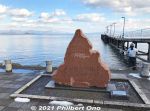
Biwako Shuko no Uta Birthplace Monument, Imazu. This is Imazu's second monument for the song. 全歌詞碑の「琵琶湖周航の歌」誕生の地 今津。今津港。背景には竹生島行きの船。Imazu has two monuments for the song. The first one is a lamp at the end of the pier (visible in this picture on the right of the boat). That was for Verse 3 which is written on the lamp post.
Later in 1994, Imazu town built this red clay monument to commemorate the song's birth in Imazu. The entire lyrics is also engraved. It is next to the Imazu boat pier where boats depart for Chikubushima. Looks like a red flame, but it's shaped after the geographical shape of Imazu town.
|
|
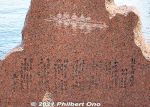
The monument is engraved with the entire song and a picture of rowers.
|
|
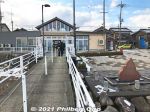
Imazu Port. The song monument is on the right. Looks like a "red fire" as mentioned in the song.From Imazu Port, you can easily go to Chikubushima island by boat, from where you can take another boat to Hikone or Nagahama. Going vice versa is possible too. It's a great way to traverse the lake.
See more photos of Imazu here.
|
|

Song Monument, Imazu. Looks like red fire, but it's also the shape of Imazu town. (The background shows the old Imazu Port building.)Directions: From Omi-Imazu Station on the JR Kosei Line, get out the east exit and walk on the main road toward the lake. You will soon see the Biwako Shuko no Uta Shiryokan song museum on the left. Be sure to visit this museum too. Walk further toward the lake and you will see Imazu Port. Near the water, you can see the "red fire" song monument. On the very end of the pier, and you can see the lamp monument. (The pier might be closed off if there is no boat, so you may have to ask permission to walk on the pier.) Omi-Imazu Station also has a tourist information office where you can obtain directions and a map.
|
|

Song monument at Imazu Port.
|
|
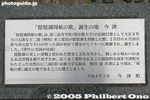
Song Monument plaque, Imazu. It explains about how the song was created in Imazu.
|
|

Imazu Port and song monument in winter snow.
|
|

Chikubushima island and snowly Mt. Ibuki in the background.
|
|
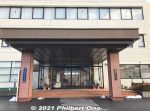
Biwako Shuko no Uta Shiryokan (Lake Biwa Rowing Song Museum) moved to this building's 1st floor and opened on April 1, 2020. This is the Imazu-Higashi Community Center (今津東コミュニティセンター).Right across from the Imazu Shimin Kaikan concert hall.
|
|
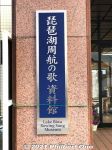
The museum sign includes English! Official English name is "Lake Biwa Rowing Song Museum." 琵琶湖周航の歌資料館
|
|

Entrance to the new Biwako Shuko no Uta Shiryokan (Lake Biwa Rowing Song Museum) in Imazu. 琵琶湖周航の歌資料館
|
|
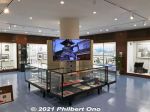
The museum has various panel exhibits, videos, etc. Currently, no explanations in English. Tokiko Kato scored a national hit with the song in 1971.
|
|
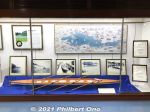
Model of fixed-seat boat used during Oguchi Taro's time in 1917.
|
|
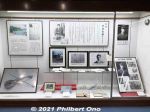
Exhibit for Oguchi Taro who composed the song.
|
|
|
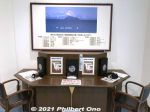
CD listening station for many cover versions by famous Japanese singers and groups. There are many, and you can listen to each of them.The song was included in a record for the first time in 1958 when Kyoto University made an album of its university songs on the 90th anniversary of the school's founding. In 1961, a chorus group named Boney Jacks recorded the song in an album of Japanese songs. And so did singer Peggy Hayama in 1962.
|
|
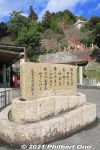
Verse 4 Song Monument, Chikubushima. Built in 1987 by Biwako Kisen, tour boat operator. 四番の歌碑。竹生島の桟橋のすぐそば。琵琶湖汽船が寄贈。The monument is right near the island's boat pier.
See more photos of Chikubushima here.
|
|
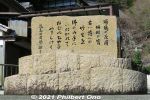
Verse 4 Song Monument, ChikubushimaAzure blue flower garden, revered coral shrine.
Full of old-time stories, Chikubushima.
In the hands of Buddha, one young maiden lies.
She's sleeping in compassion, resting peacefully.
Ruri no hanazono, sango no miya
Furui tsutae no, Chikubujima
Hotoke no mite ni, idakarete
Nemure otomego, yasurakeku
瑠璃の花園 珊瑚の宮
古い伝えの 竹生島
仏の御手に いだかれて
ねむれ乙女子 やすらけく
|
|
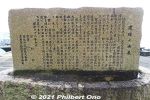
Rear of Verse 4 Song Monument, Chikubushima.It explains about the origin of the song. The monument was donated by the Biwako Kisen tour boat company which operates the boats going to the island as well as other tour boats in Lake Biwa, including the Michigan paddlewheel boat based in Otsu.
|
|

Chikubushima boat dock. The Verse 4 Song Monument on can be seen on the left.
|
|

Verse 3 Song Monument, Nagahama. Built and unveiled on June 25, 2017 by a non-profit citizens group in Nagahama formed to build this new song monument for the song's 100th anniversary. 三番の歌碑。長浜城のそば�The new Verse 3 Song Monument is near Nagahama Castle near the lake shore. It was unveiled with great fanfare by singer Kato Tokiko and others.
|
|
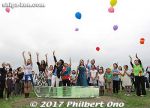
The song monument is made of glass and functions as a park bench for four people. Glassware is one of Nagahama's signature products. Verse 3 is engraved in the middle. It reportedly cost several million yen.After the unveiling, local singers sang the song with Kato Tokiko before everyone released balloons.
|
|

The first people to sit on the song monument. L-R: Nagahama-native Kitagawa Akihiro of the duo ~Lefa~, singer and special guest Kato Tokiko, Kada Yukiko former Shiga governor, and the mayor of Nagahama.
|
|

On June 26, 2017, alumni of the Kyoto University Rowing Club rowed around Lake Biwa and took a break at Nagahama where they sang in front of the new song monument.
|
|

Verse 3 Song Monument at Nagahama's Hokoen Park. It is shaped like a boat and the top has a wavy surface like the water. It is called the "nami-makura" (rolling waves) design.The glass bench is positioned for sunset views over the lake.
Update: Unfortunately, this glass bench monument cracked and was replaced with another bench monument in Sept. 2021.
|
|

Verse 3 Song Monument in Nagahama's Hokoen Park near Nagahama Castle is engraved with Verse 3.浪のまにまに 漂えば
赤い泊火 懐かしみ
行方定めぬ 浪枕
今日は今津か 長浜か
Nami no mani mani, tadayoeba
Akai tomaribi, natsukashimi
Yukue sadamenu, nami makura
Kyo wa Imazu ka, Nagahama ka
|
|

The glass bench actually consists of several glass pieces. A few are largely transparent.
|
|

It's a beautiful design, but quite expensive. The non-profit group was unable to garner enough donations for the monument. They fell far short of the ¥10 million goal.
|
|

Verse 3 Song Monument at Nagahama's Hokoen Park. It is shaped like a boat and the top has a wavy surface like the water. It is called the "nami-makura" (rolling waves) design. Since the original glass bench song monument broke, it was replaced by this one made of stone having a similar shape and design concept.
|
|

Verse 3 Song Monument in Nagahama's Hokoen Park near Nagahama Castle is engraved with Verse 3.Nami no mani mani, tadayoeba
Akai tomaribi, natsukashimi
Yukue sadamenu, nami makura
Kyo wa Imazu ka, Nagahama ka
浪のまにまに 漂えば
赤い泊火 懐かしみ
行方定めぬ 浪枕
今日は今津か 長浜か
We drift from wave to wave, straying aimlessly.
On shore we see red fire, brings back memories.
With our sights set nowhere, rolling with the waves.
Today is Imazu or, Nagahama huh.
|
|

This side of the monument faces the lake. It's a popular bench to sit on during weekends and holidays.
|
|
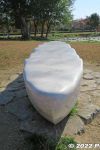
Wavy bench surface.
|
|

Verse 5 Song Monument, Hikone Port 五番の歌碑。彦根港The left stone is inscribed with the entire song, and bigger stone on the right has the lyrics for verse 5. There is also another stone which shows a map of the lake and rowing route. The monument is now encroached by tall grass and weeds.
This song monument was built in Oct. 2005 at a cost of 8 million yen (gathered through donations). With this, now all six verses each have a song monument. This one is next to Hikone Port where you board the boat to visit Chikubushima or Takeshima.
|
|

Close-up of main stone monument where Verse 5 is written. 2005年10月に除幕されて一番新しい歌碑。800万円の寄付金で建てた。Sharp arrows buried deeply, way into the ground.
Abundant summer grasses, a moat still remains.
Standing in an old castle, all alone oneself.
Hira and Ibuki too, only but a dream.
Ya no ne wa, fukaku uzumorete
Natsukusa shigeki, hori no ato
Kojo ni hitori, tatazumeba
Hira mo Ibuki mo, yume no goto
矢の根は 深く埋もれて
夏草しげき 堀のあと
古城にひとり 佇めば
比良も伊吹も 夢のごと
|
|

Verse 5 Song Monument, the third monument showing the rowing route, Hikone PortThe monument's third stone shows a map of the lake and rowing route. It also states the dates when all the song monuments were built in Shiga.
See more photos of Hikone here.
|
|

Verse 5 Song Monument facing Hikone Port. See more photos of Hikone here.The three-stone monument is in a good location facing Hikone Port. This photo was taken soon after the monument was built. Over the years, wild grass or weeds have invaded the monument plot.
|
|

Verse 6 Song Monument, Chomeiji Port. Built in 1998. 六番の歌碑。長命寺(バス停のすぐそば)Near the Chomeiji bus stop. It faces the pier. This monument has the most number of stones. But only two of them are used.
See more photos of Chomeiji Temple here.
|
|

Kyoto University Rowing Club visit the Verse 6 monument during their during their annual Lake Biwa rowing trip. 写真/尾城徹雄Chomeiji is one of their overnight stops during their 3-day rowing trip.
|
|

Main stone of Verse 6 Monument 問題の「西国十番」が刻んでいない。Saigoku pilgrimage, Chomeiji.
Dispel this world's impureness, very faraway.
Golden waves on which we weave, rowing all we can.
Tell us my friends your stories, with your fervent hearts.
Saigoku Juban, Chomeiji
Kegare no utsushiyo, tooku sarite
Kogane no nami ni, iza kogan
Katare wagatomo, atsuki kokoro
西国十番 長命寺
汚れの現世 遠く去りて
黄金の波に いざ漕がん
語れ我が友 熱き心
|
|

The first verse is wriiten, but the first line about Chomeiji being the 10th temple in the Saigoku Pilgrimage is omitted.Chomeiji is the 31st temple in the Saigoku Pilgrimage, not the 10th temple as sung in the song.
|
|

Rear of Verse 6 monument. Next to the main stone is a plaque for the entire lyrics.
|
|

Plaque for entire lyrics, Verse 6 Song Monument, ChomeijiJapanese lyrics of the entire song consisting of 6 verses.
|
|
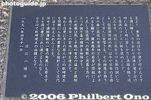
Message plaque, Verse 6 Song Monument, Chomeiji
|
|

Verse 6 Song Monument facing Chomeiji pier
|
|

Verse 6 Song Monument, Chomeiji Temple. Built in Nov. 2011.Directions: From Omi-Hachiman Station on the JR Biwako Line, take a bus to Chomeiji. Takes about 20 min. Omi-Hachiman Station has a tourist information office where you can obtain directions and a map. You can also rent a bicycle at the station and follow the map to Chomeiji Port. The monument is in a small park in front of the port near the Chomeiji bus stop. The other Verse 6 monument is within the Chomeiji temple grounds. Climb the 800 steps (quite strenuous) to the temple or call a taxi to drive up near the top.
|
|

Donated by Omi-Hachiman resident Fukao Katsuyoshi and unveiled on Nov. 5, 2011.
|
|

Unlike the song monument at Chomeiji Port, this monument includes the first line of Verse 6 with the mistaken "Saigoku Pilgrimage 10th temple."
|
|

The monument is in a very good location within the Chomeiji temple grounds. All temple visitors have to pass by the monument. It also overlooks the lake.
|
|

Oguchi Taro Statue and Biwako Shuko no Uta Song Monument. On the shore of Lake Suwa, Okaya, Nagano. 歌碑と小口太郎銅像This was where I first heard the song, "Biwako Shuko no Uta." In May 2004, I was in Suwa, Nagano Pref. to see and photograph the Onbashira Festival (held every 6 years). My hotel was in the neighboring city of Okaya on the shores of Lake Suwa.
I walked around the lake and came across this statue of Taro Oguchi and song monument. I was very surprised when I saw the word "Biwako" (Lake Biwa). This was Nagano, not Shiga, so it was most unexpected to see "Biwako" here. I read the song lyrics on the monument and was surprised and delighted to see the names of well-known places in Shiga.
The monument even had music box (seen on left) where you could hear three versions of the song. I immediately found it intriguing.
|
|

About Taro Oguchi.The song was written as a collaboration among boatmates, but Taro Oguchi (小口太郎) (1897-1924) is credited as being the main song writer. He was born in 1897 (Meiji 30) in Minato-mura village, now part of Okaya city on the shores of Lake Suwa in Nagano Prefecture.
He grew up in a loving and respected family and demonstrated an early talent for writing, music (violin and shakuhachi), and sports (judo, skiing, skating). Since he was the eldest son expected to take over the family home, there was opposition for him to go away for college. However, his father was persuaded to allow Taro to apply for college at the elite No. 3 High School (later to become Kyoto University). It was one of nine college-level schools in Japan, the No. 3 school being one of the most elite.
Contrary to family expectations, Taro passed the entrance exam, went school in Kyoto in 1914 and joined the rowing and speech clubs. In 1917, he wrote the famous song about Lake Biwa which first went public in 1918.
|
|

Statue of Oguchi Taro 小口太郎銅像Short walk from JR Okaya Station. Walk toward the shore of Lake Suwa. The monument is near the mouth of Tenryu River.
|
|

Closeup of Taro Oguchi statueHe graduated in 1919 and furthered his studies at Tokyo Imperial University (now University of Tokyo) in the science department. In 1921, he invented the wired and wireless multiplex telegraph and telephone system which was patented in eight countries. He was an extremely bright young man with a promising future.
In 1922, he entered the university's aeronautical research institute as a researcher. However, his life soon took a downturn from 1923 when he received a military conscription notice. A love interest for marriage also did not work out as desired. His physical health deteriorated and he terminated his own life the following year in 1924 at age 26.
|
|

Rear view, looking toward Lake Suwa.
|
|
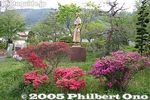
Side view of Taro Oguchi Statue and Song Monument in spring with azaleas.
|
|

Side view of Taro Oguchi Statue and Song Monument in winter. 小口太郎顕彰碑
|
|

Music box. Three versions of the song can be heard through a speaker by pressing a button. Also see the video at YouTube to hear the song.The monument included a music box where you could listen to three versions of the song through a speaker. I was immediately fascinated by the song when I heard it (together with the wind and waves of Lake Suwa).
|
|

Song monument with the entire lyrics of Biwako Shuko no Uta. On the shore of Lake Suwa in Okaya, Nagano. 琵琶湖周航の歌 全歌詞碑
|
|

Biography of Oguchi Taro. 小口太郎顕彰碑
|
|

Biography of Oguchi Taro
|
|

Area of the Oguchi Taro monument (seen on left), in winter.
|
|

Smaller statue of Oguchi Taro inside Okaya City Hall, next to the entrance.
|
|

Printable map and directions to all song monuments. Google map 歌碑の案内地図Also see this Google map: Google map
|
|
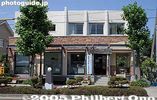
The old Biwako Shuko no Uta Shiryokan (Lake Biwa Rowing Song Museum), Imazu 琵琶湖周航の歌資料館、今津町This museum dedicated to this song opened in April 1998 in Imazu. It is a 3-min. walk from Omi-Imazu Station on the JR Kosei Line. Closed in March 2020 and moved to a new building.
Hours: 9 am to 5 pm, closed Mon. (open if Mon. is a national holiday, and closed on Tue. instead)
Free admission.
|
|
|
|
|